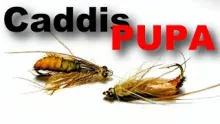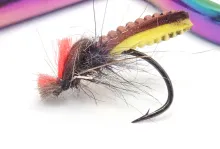This fly is similar in outline to many existing caddis patterns, but has features unlike any caddis emerger pattern the originator has seen. It's based not so much on looking exactly like the real thing, but trying to get a fly to act like it.
It was a sunny day
in mid June that found me up at Lost Lake in the middle of a three-way hatch. I had gray drakes crawling up my waders and flying off and I had two species of caddis pupae wriggling around in the water attempting to emerge around me. The lake was very low and warm, and I was getting no action with the various mayfly patterns I had been trying. In desperation I tied on the orange version of a caddis pupa emerger I had modeled on a live one that had emerged a week earlier from the aquarium I have in my bathroom.
While this fly
was similar in outline to many existing patterns, it had features unlike any caddis emerger pattern I had seen to date, and was based not so much on looking exactly like the real thing, but trying to get a fly to act like it. I was also wary because of the garish colours I had used in copying the original live model, even though I could see that the ones around me were very similar. I cast as best I could, which is not well, and after letting it sink for about 15 seconds, began a slow retrieve. There was an almost instant hit and run and I found the fly gone when I got to the end of the leader. The knot had failed. This was the first action I had had all day. I quickly dove into my box and discovered that I did not have another orange version, only the brown one. Tying that on in eager anticipation, I cast again, let it sink and began the retrieve. I spent the rest of that day failing to connect to any of the numerous subtle bumps and follows I got. But it was action, despite my lousy casting. I had discovered that they were not hitting mayflies, but caddis pupae and doing so very gently.
Towards late afternoon
I began to notice a few rises to drowned hatched caddis, and tied on an elk hair caddis, a deer hair caddis and then every other caddis adult I had, with no interest what-so-ever shown by the trout, despite the flies being very good supposed matches for what was in the water. The flies either floated too high, or sank badly, and as the water was clear as crystal, the fish could easily spot the fakes and did not bite. I needed a caddis that floated low in the water, wasn’t too bushy but still had a good profile from below, and didn’t sink too quickly. I decided to try adding CDC to the wing, so that I could get the floatation, and there-by be able to thin out the bulk of the wing a bit, with the resulting flies looking very pleasing. I have tested them with success on local rivers, but have not made it back to Lost Lake at a time to meet that hatch again. The colours and sizes of the patterns were direct copies from the naturals I captured and brought home for the purpose. Used in conjunction with the Action Emerging Caddis, I am looking forward to the next time I encounter that particular hatch on Lost Lake.
Tying the Action Emerging Caddis
The tail fibers are first placed together into a single clump, then tied in by the butts at the bend of the hook. Measured out to about equal or slightly longer then the actual hook length, it is then lightly twisted and folded back on itself, and then tied in at the bend. Next, a second clump, similar to the first is tied in and wrapped just as if it were peacock or ostrich herl, forward to complete the rear half of the body. The front half of the body is dubbed in, and the six legs are tied in under the body, and then the wings are tied in, slung low. They should extend almost out to the hook bend. The antennae are tied in, then the eyes, then the head is dubbed in and the fly finished.
The purpose
of the twisting and folding of the marabou is that in the real insect, the body does not fluff out and in with each twitch of the retrieve, it wriggles in a distinct up and down motion. By folding it over on itself and twisting it, the fluffing outwards is prevented, but the fibers are allowed to wriggle like gills, and the whole mass wriggles in a relatively life-like fashion as compared to loose marabou. Eyes are not entirely necessary, but look good, and the legs and antennae are required, though fish can’t count, so while there are eight actual appendages, six legs and two antennae, I don’t think trout would mind if you were a couple short or over, just keep it sparse. The legs though should splay out in a really sloppy fashion when fished. This seems to draw attention to the fly better then if they just fold up and vanish in the tail. Looks more alive then that way.
The Lost Lake
series of caddis adults are simply stripped down and colour matched Deer-hair caddis. They float like they should, and work well enough in rivers and else-where I have tried them, but then that pattern is a well proven winner anyway. My little adjustments are just that, minor tweakings to fit a particular moment. The CDC is tied in under the deer or elk hair wing and helps the fly float in the surface film as a spent adult might, rather then on top or under, though the fly certainly works well enough as a barely sunk fly, with a twitch now and then thrown in to the retrieve.
- Log in to post comments












